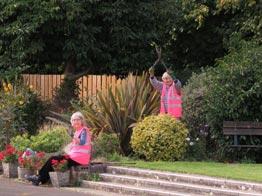
5 minute read
Home & Garden
The West Dorset Magazine, November 4, 2022 55 Homes & Gardensx Green-fingered volunteers on right track
Green-fingered volunteers and railway staff have been recognised for their efforts to bring a splash of colour to West Dorset’s railway stations. South Western Railway (SWR) hosted this year’s Stations in Bloom awards at Castle Gardens in Sherborne, where volunteers were rewarded for their hard work planting flowers and small shrubs. The awards ceremony followed SWR’s Big Bulb Plant Out, during which staff and volunteers planted over 17,000 bulbs at 35 locations across the operator’s network including West Dorset. Stations In Bloom is based on the competition run by the Royal Horticultural Society and was organised by Blackmore Vale Line Community Rail Partnership, which has been helping to spotlight the work of station volunteers and railway staff since its inception in 2016. An SWR spokesperson said: “All the stations that were judged were commended in some way for their contributions to the betterment of the railway. “The daffodils, tulips, crocuses, and other flowers will breathe new and colourful life into stations when they begin to bloom in the springtime next year, helping to make the SWR network more welcoming and enjoyable for customers. “They will also enhance the biodiversity of the network in line with SWR’s commitment to improve sustainability, providing new havens for bees, butterflies, and other insects and species to thrive and support the local natural environment. “Based on the guiding principles of community involvement, sustainability, and horticultural prowess, the awards event was culmination of a summer of judging which considered floral displays, the range of activities by volunteers, positive environmental impact, community engagement with schools and other local groups, and coordination with onward transport links.”
Advertisement
JUST THE TICKET: Working hard on the Stations in Bloom awards
LOCKSMITHS
Security Industry Since 1990
�� �� �� �� Emergency call out gain entry, lock & burglary repairs �� �� �� �� Emergency safe opening �� �� �� �� Key cutting (on site) �� �� �� �� Garage locks fitted & supplied �� �� �� �� Digital & electronic locks �� �� �� �� Window & door furniture supplied & fitted �� �� �� �� Free security survey �� �� �� �� Supply & fit/change all types of locks (to BS 3621) �� �� �� �� UPVC/ wood/ aluminium/steel doors & window glazing �� �� �� �� Alarms & CCTV supplied & fitted �� �� �� �� Auto locksmith gain entry �� �� �� �� Boarding up services

BRANCH LINE; Volunteers on the railway Email: Info@quantumlocksmiths.co.uk Web: www.quantumlocksmiths.co.uk

56 The West Dorset Magazine, November 4, 2022 Homes & Gardens x Horticulture...
...with botanist Dr Dave Aplin
Born and bred in West Dorset, Dave has worked in horticulture and botany locally and internationally, notably in Belgium, Jordan and the UAE. He brings a wealth of practical knowledge with its underlying principles to his writing Great impressionists of the plant world
The process of evolution favoured the stick insect’s body to mimic a twig. This occurred through millions of years of natural selection with those insects having the most effective camouflage surviving and passing their genes to the next generation. This form of mimicry is not confined to insects. Plants can also be superb mimics. Perhaps one of the best examples can be found a short walk from your backdoor. The one plant every child quickly learns is the stinging nettle. Their leaves have razorsharp hairs constructed with silica that terminate to fragile tips. When brushed the tips shatter, releasing venom. Nettle’s venom comprises three kinds of acid, when injected onto the skin they cause the tingling pain that everybody knows. Once touched, never forgotten so we all prefer to steer clear of them. Grazing animals act similarly, leaving the plant largely untouched. Growing in the same habitat as nettle is an unrelated plant known as the white dead nettle. The plant’s similarity to stinging nettle is remarkable. It lacks stinging hairs, yet the dead nettle’s close resemblance to the real nettle proves sufficient to avoid being eaten. As with stick insects, those dead nettles resembling stinging nettles the closest have the greatest chance of survival and pass their genes to the next generation. To the casual observer both plants look identical, but during the autumn and winter, the doppelgangers are betrayed by producing attractive white blooms arranged in whorls around square stems, contrasting with stinging nettle’s green, summer flowers. Several other plants in our gardens adopt different types of mimicry. Deceptive orchids are well known for mimicking insect mates to lure pollinators. Other plant groups have evolved pungent odours and alluring colours to mislead insects. The garden plant dragon arum, Dranunculus vulgaris, from the arum family is a good example. Its huge flower mimics a rotting corpse in both colour and smell. This tempts droves of carrion flies to the inner crypt of the bloom in search for a suitable place to lay their eggs. Of course, this deception is no place for developing maggots, but this botanical invitation is sufficient for the plant to deposit pollen the visiting flies that, with luck, taxi it to another flower of the same species. Aren’t plants amazing!
MIMICS: Dragon arum, left, and nettle, right
Nobody likes to think about getting old, but it is certainly worth thinking about if you value your home. That is because your house could very well be sold by the local council to pay for your care fees. As an example, let’s say you own a home jointly with your partner and you live there until one of you dies. The surviving partner continues to live in the house until they must go into a care home run by the local authority. At that point, the local authority will assess the surviving partner for care fees. If their capital and savings are worth more than £23,250, they will have to fund their own care. Councils place a charge on the property, which is paid when the house is sold. Alternatively, you may be required to sell the house immediately to raise the cash. Money raised from the sale of the house will fund your care until your savings get down to £23,250. There are two solutions to the problem available to you. One is a will trust which protects 50% of the value of your home from care costs. The second is a living trust which shields 100% of the property. Both are relatively inexpensive to put into place. Every trust is administered by trustees, the trustees can be the partners or surviving partner and children. Chris Tennant of Oakwood Wills said: “The main thing to remember with trusts is that because you do not own the assets held in the trust in your own name, it is more difficult for those assets to be taken away from you or from the beneficiaries of the trust.” Contact Chris on 07832 331594.






